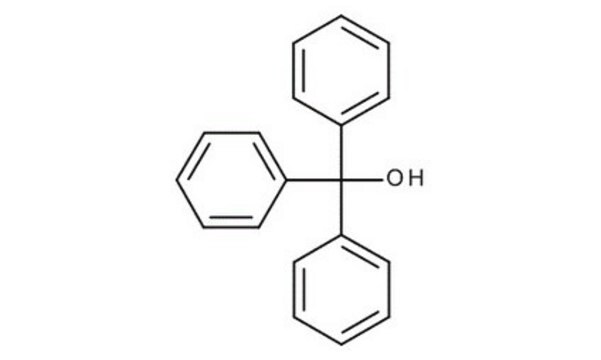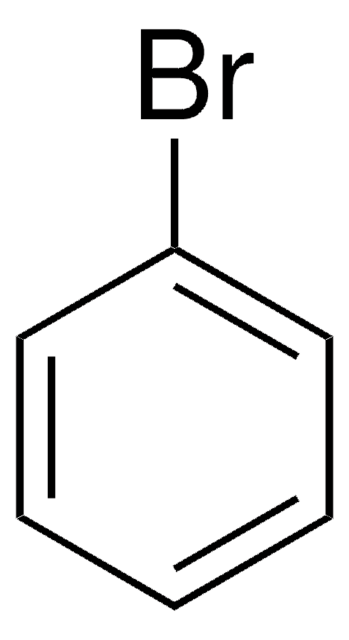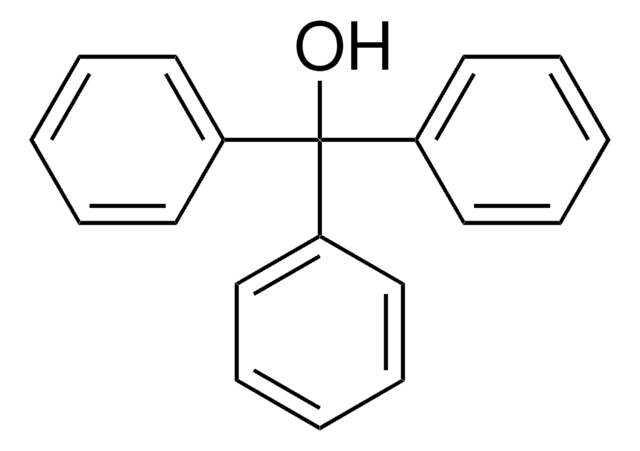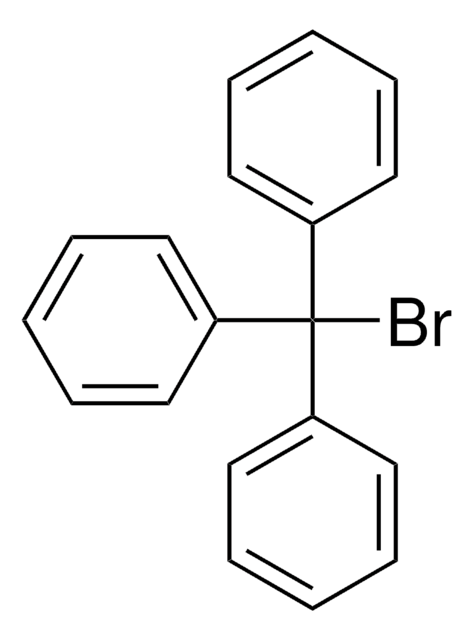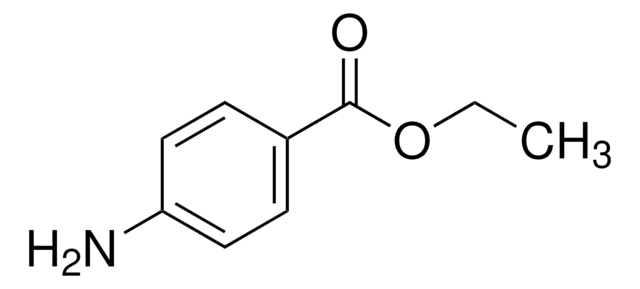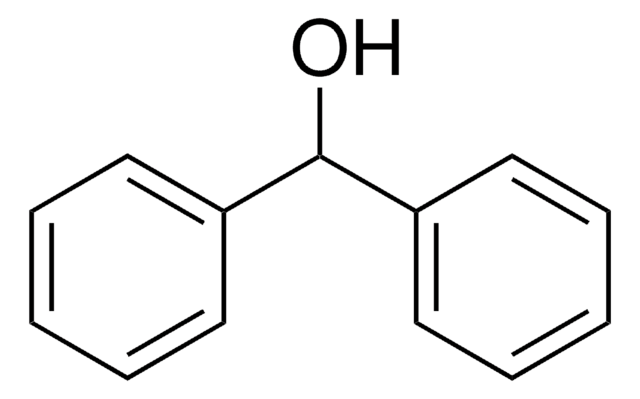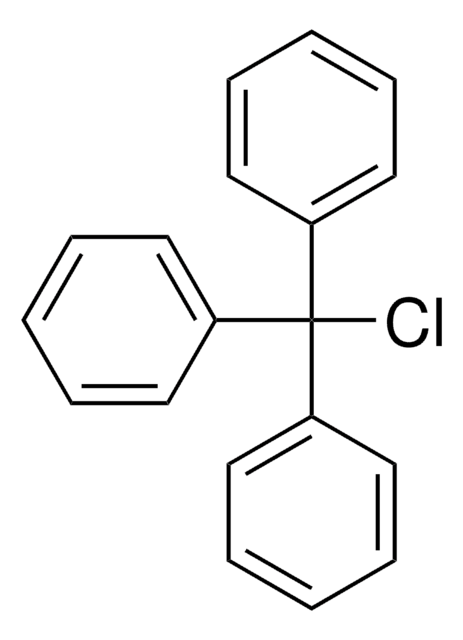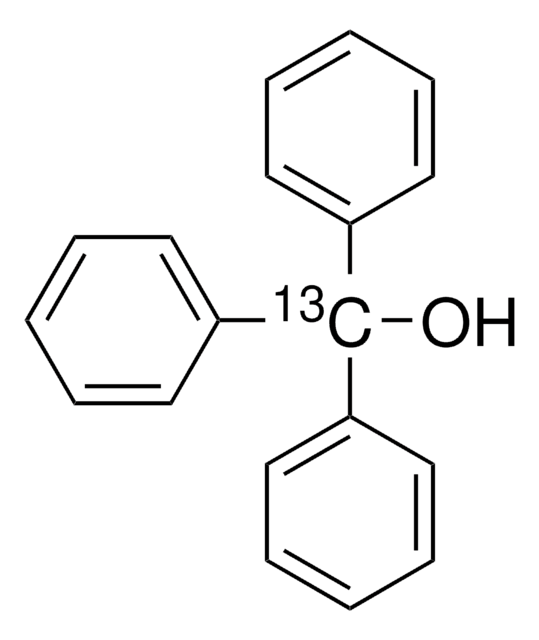134848
Triphenylmethanol
97%
Synonym(s):
Triphenylcarbinol, Trityl alcohol
Sign Into View Organizational & Contract Pricing
All Photos(1)
About This Item
Linear Formula:
(C6H5)3COH
CAS Number:
Molecular Weight:
260.33
Beilstein:
1460837
EC Number:
MDL number:
UNSPSC Code:
12352100
PubChem Substance ID:
NACRES:
NA.22
Recommended Products
Quality Level
Assay
97%
form
solid
bp
360 °C (lit.)
mp
160-163 °C (lit.)
solubility
dioxane: soluble 100 mg/mL, clear, colorless to faintly yellow
functional group
hydroxyl
phenyl
SMILES string
OC(c1ccccc1)(c2ccccc2)c3ccccc3
InChI
1S/C19H16O/c20-19(16-10-4-1-5-11-16,17-12-6-2-7-13-17)18-14-8-3-9-15-18/h1-15,20H
InChI key
LZTRCELOJRDYMQ-UHFFFAOYSA-N
Looking for similar products? Visit Product Comparison Guide
Related Categories
General description
Triphenylmethanol forms 1:1 molecular complex with triphenylphosphine oxide. It is a specific clathrate host for methanol and dimethyl sulphoxide and forms clathrate inclusion complexes. It undergoes reduction to triphenylmethane by 9, l0-dihydro-10-methylacridine in the presence of perchloric acid.
Application
Triphenylmethanol was used in the synthesis of of the two-electron reduction product of pyrylogen.
Storage Class Code
11 - Combustible Solids
WGK
WGK 3
Flash Point(F)
Not applicable
Flash Point(C)
Not applicable
Personal Protective Equipment
dust mask type N95 (US), Eyeshields, Gloves
Choose from one of the most recent versions:
Already Own This Product?
Find documentation for the products that you have recently purchased in the Document Library.
Customers Also Viewed
Steiner
Acta crystallographica. Section C, Crystal structure communications, 56 (Pt 8), 1033-1034 (2000-08-16)
In the crystalline 1:1 molecular complex of triphenylmethanol (TPMeOH) and triphenylphosphine oxide (TPPO), C(19)H(16)O. C(18)H(15)OP, molecular dimers are formed which are linked by O-H. O=P hydrogen bonds. The dimers are aligned by sixfold phenyl embraces to form columns. The structure
Tamer T El-Idreesy et al.
Photochemical & photobiological sciences : Official journal of the European Photochemistry Association and the European Society for Photobiology, 9(6), 796-800 (2010-05-12)
The first synthesis of the two-electron reduction product of a pyrylogen is reported. The magnitude of the experimentally determined disproportionation constant for a pyrylogen radical cation was used to advantage in order to provide compelling evidence for formation of this
Efficient Reduction of Triphenylmethanol to Triphenylmethane by 9, l0-Dihydro-10-methylacridine in the Presence of Perchloric Acid.
Ishikawa M, et al.
Chemical Society, Analytical Methods Committee, Analyst, 62, 3754-3756 (1989)
Specific entrapment of methanol and dimethyl sulphoxide (DMSO) by a simple host compound (triphenylmethanol). Crystal structures of the Ph3COH? MeOH (1: 1) and Ph3COH? DMSO (2: 1) clathrate inclusion complexes.
Weber E, et al.
Journal of the Chemical Society. Chemical Communications, 17, 1195-1197 (1989)
Corinne Nguyen et al.
Journal of medicinal chemistry, 49(14), 4183-4195 (2006-07-11)
We report the discovery of novel uracil-based acyclic compounds as inhibitors of deoxyuridine 5'-triphosphate nucleotidohydrolase (dUTPase), an enzyme involved in nucleotide metabolism that has been identified as a promising target for the development of antimalarial drugs. Compounds were assayed against
Our team of scientists has experience in all areas of research including Life Science, Material Science, Chemical Synthesis, Chromatography, Analytical and many others.
Contact Technical Service